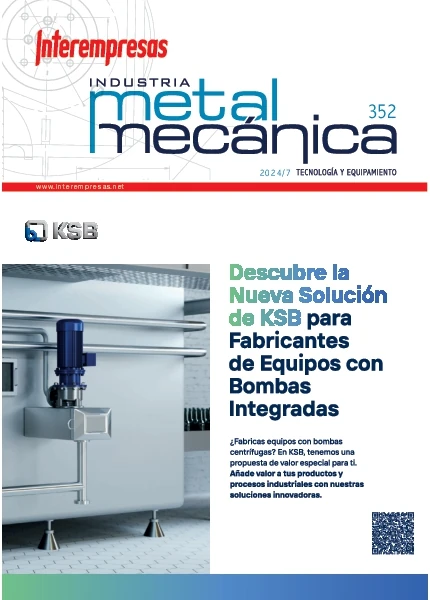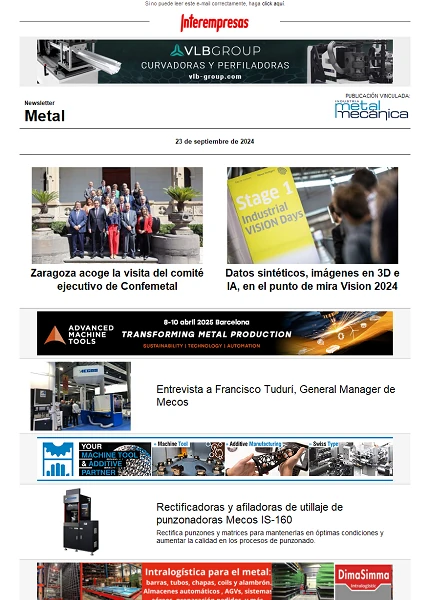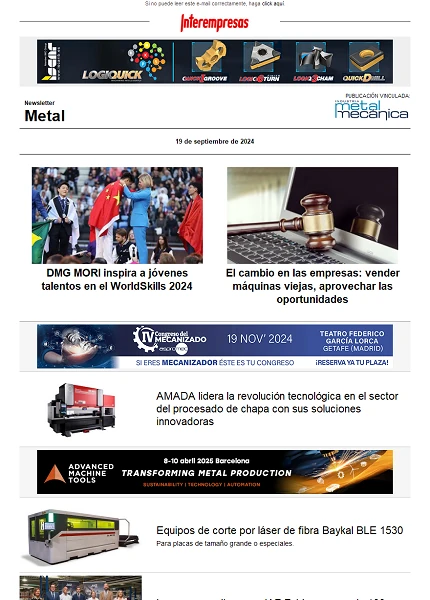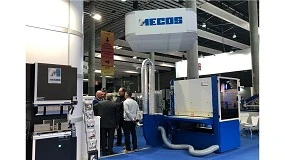El diseño industrial liga a las empresas a funciones no bien resueltas
En la clasificación de los principales productores de máquina herramienta, Japón sigue en primer lugar, seguido de Alemania y Estados Unidos. España ocupa la octava posición con cerca de 900 millones de dólares
Se debe tener en cuenta que algunas de las empresas consultadas, aunque se posicionan cada una en un sector, fabrican productos considerados en diferentes segmentos.
De esta forma, nos encontramos con los segmentos de actividad de fresadoras, máquinas especiales, tornos, centros de mecanizado, rectificadoras máquinas de procesos químicos, tronzadoras y taladros,
Y, por otro lado, en el sector de la deformación y están los segmentos de prensas mecánicas, punzonadoras, prensas hidráulicas, dobladoras, plegadoras y cizallas.
¿Qué se entiende por diseño industrial?
Mientras que una gran mayoría de los encuestados entiende que es una disciplina que ayuda a mejorar la percepción de la calidad de las máquinas y de la imagen de la empresa, un porcentaje importante piensa que el diseño industrial debe adaptar las máquinas a los costes del mercado.
Estos datos, confrontados con la realidad experimentada día a día, hacen pensar que la interpretación de la palabra diseño hace más referencia a la consecución de funciones primarias del producto, al diseño más tangible, más mecánico, que a motivaciones intangibles, de las que debieran de estar impregnadas productos más evolucionados.
Otro dato a destacar de la encuesta es el hecho de que en este sector se integran como si fueran un todo, sin separación, el diseño industrial y la ingeniería, ya que el 55 por ciento de los encuestados, entiende que el diseño industrial engloba una actividad de ingeniería que persigue la mejora de los sistemas y subsistemas mecánicos que constituyen la máquina.
El panorama se complementa con un 50 por ciento de los encuestados que considera que la actividad del diseño industrial debe ir buscando la introducción de nuevas tecnologías y patentes.
Atributos fundamentales del diseño industrial
Estos datos son coherentes con la valoración hecha en el punto anterior y entre sí, pues el objetivo final de la aportación del diseño debe ser la mejora de las ventas.
Los atributos relacionados con las mejoras en el sistema de producción que puede aportar el diseño industrial y su aportación en las reflexiones sobre las necesidades del mercado o del cliente reflejan una cierta disminución de su importancia con un 75 por ciento de los encuestados, y relegados en su prioridad a que un 25 por ciento lo sitúa en segundo lugar y un 30 por ciento los sitúan en tercer lugar, respectivamente.
Resumiendo, se puede decir, que las opiniones que refleja la encuesta corroboran la impresión expresada sobre el uso primero que del diseño industrial hacen las empresas del sector de la máquina-herramienta, más ligado a funciones primarias, tradicionalmente no bien resueltas. En la medida en que éstas se diesen por supuestas, surgiría un diseño más dirigido a potenciar valores intrínsecos, intangibles de la empresa, que forman parte del alma de la misma y que con seguridad serán diferenciadores.
El tamaño reducido de las empresas del sector en España es otro condicionante que limita el poder disponer de horizontes más amplios.
Otros atributos del diseño industrial
- El 100 por cien identifica las consideraciones de la ergonomía y la seguridad en el campo del diseño industrial.
- El 95 por cien relaciona el cumplimiento de las normativas y los aspectos de innovación como la incorporación de nuevos materiales asignados al entorno del diseño industrial.
- El 90 por cien incide en que el diseño industrial aporta mejoras en los aspectos estéticos y crea sinergias hacia otros productos de la empresa.
- El 85 por cien asocia la necesidad de que el diseño industrial considere el eco diseño como factor importante en el sector.
- Es claro que los aspectos físicos que aportan las máquinas, tienen una gran importancia, y así lo reflejan los números, pero se nota que no se le da la misma relevancia a las consideraciones intangibles que a esos aspectos deben acompañar.
El diseño industrial como disciplina que mejora la imagen
- El 100 por cien de los encuestados reconoce que el diseño industrial influye y mejora la imagen de marca de la empresa.
- El 95 por cien considera que además el diseño industrial influye y mejora la imagen de la empresa y la percepción de la calidad del producto.
A pesar de estas contestaciones, se destacará más adelante en el estudio que en el pliego de condiciones pocas veces aparecen aspectos de imagen, que son relegados a los departamentos comerciales y enfocados fundamentalmente hacia la confección de los catálogos de productos.
La tradicional separación de responsabilidades entre los departamentos comerciales (comunicación imagen de marca y de empresa) y de I+D, u oficinas técnicas (imagen de producto), hace que se traten de formas diferente con la consiguiente falta de homogeneidad y coherencia.
Estos datos que recoge la encuesta, con práctica unanimidad entre las personas entrevistadas, son una buena base para pensar que la implantación con cierta fuerza del diseño industrial en el sector es cuestión de hace unos pocos años.
Experiencia en diseño industrial
El 75 por cien reconoce haber trabajado con diseñadores exteriores, calificando la experiencia como buena un 45 por cien, regular un 25 por cien y mala un 5 por cien.
Dentro de esta relación con diseñadores industriales externos, los tipos de servicio que más aprecian de éstos, son:
Un 65 por cien aprecia la aportación en la generación de conceptos
Un 75 por cien valora las propuestas de configuración formal y constructiva
Un 50 v valora positivamente la intervención en la industrialización
Contra estos datos se encuentra la declaración de las propias empresas, sobre la forma en la que han trabajado los proyectos mas destacados de los últimos años, en los que mayoritariamente declara haber desarrollado internamente el diseño industrial. Por otra parte, el dato cierto de la carencia interna en plantilla de diseñadores industriales, pone en cierto modo en entredicho el convencimiento con el que se expresan las bondades que debiera reportar el diseño industrial. También es cierto que un porcentaje importante de empresas entrevistadas ha trabajado con diseñadores industriales externos y que los resultados, no especialmente bien valorados, hace que este tipo de colaboraciones se realicen de forma errática, puntual, situación que se agrava por los ciclos profundos a los que periódicamente el sector se ve sometido.
Las causas que identifican para la existencia de esta dificultad son:
• Producto no susceptible de aplicar diseño industrial, 14,3 por cien.
• Desconocimiento de la actividad, 28,6 por cien.
• Desconfianza en la actividad, 28,6 por cien.
• Mala experiencia, 28,6 por cien.
• Falta de estructura, 28,6 por cien.
A pesar de estos datos son las empresas de mayor tamaño las que tienen un mayor conocimiento de las aportaciones positivas del diseño industrial, o al menos constatan un límite en sus capacidades y sienten la necesidad de buscar ayuda para conseguir un paso más en la mejora de la percepción de la calidad de sus productos.
Aportación y ayuda de los diseñadores industriales
• El 85 por cien de los encuestados dicen que esa colaboración aporta nuevas ideas.
• El 65 por cien aprecia que ayuda al conocimiento de nuevas metodologías de trabajo.
• El 30 por cien aprecia que ayuda a mejorar la organización para el desarrollo de productos.
Si bien no disentimos de estos datos en su orden, sí que se podría decir que cuando un equipo de diseño encaja en la forma de trabajo de la empresa es utilizado con más importancia de la declarada en la mejora interna de la organización, pues debe hacer de interlocutor entre departamentos y personas que no siempre guardan la sintonía y comunicación que debiera esperarse. El diseñador externo actúa entonces a modo de aceite lubricante evitando roces y haciendo de interlocutor.
Procedimientos de desarrollo de productos
• El 75 por cien reconoce que está procedimentado el desarrollo, generalmente asociándolo a los procedimientos definidos en el sistema de calidad de la empresa.
• También el 75 por cien afirma que el desarrollo de productos está planificado.
Pliego de condiciones
En este pliego de condiciones intervienen los siguientes departamentos de la empresa:
• El 90 por cien de las veces interviene el I+D o la oficina técnica.
• El 75 por cien interviene la dirección.
• El 65 por cien interviene el departamento comercial, o el de marketing.
• El 55 por cien interviene producción.
• El 10 por cien de las veces se cuenta directamente con los clientes.
Ante estos resultados, nos preguntamos: ¿Por qué los departamentos que pueden definir mejor los aspectos intangibles tienen menos participación en la definición del pliego? ¿No interviene poco la dirección? ¿Se transmitirá adecuadamente la opinión del cliente a través de los comerciales de la empresa?. Estos interrogantes nos llevan a considerar que existe una deficiente involucración de todos los departamentos en la definición del pliego, en un momento en el que se valora mucho la multifuncionalidad del proceso de diseño y desarrollo de producto.
Integración de los diseñadores industriales
Aspectos que se consideran en el Pliego de condiciones
- El 90 por cien de las veces se definen los objetivos del proyecto, y las normativas que se deben cumplir.
- El 75 por cien se recogen los niveles de precio en los que encajar la máquina, y la política de comunicación, junto con los requisitos de materiales, aspectos de seguridad, ergonómicos y medioambientales a considerar.
- El 70 por cien de los casos se recoge el tipo de usuario al que va dirigido la máquina y las motivaciones de compra del comprador.
- El 55 por cien de los pliegos recoge las características de la competencia
- En el 50 por cien aparece además la imagen que deben transmitir las máquinas.
Los distintos porcentajes de participación de los diferentes departamentos en la definición del pliego de condiciones que se observa tras el análisis de la encuesta, son acordes con los datos que se recogen en la actividad diaria de DZ. Por ello, son deficientes los datos sobre imagen a transmitir, filosofía de la empresa, valores intangibles de la competencia, de los que se debería pretender lograr una diferenciación, etc. Nuestra observación incide en la necesidad de la consecución de una participación total, recogiendo siempre toda la información sobre la que se interroga en la encuesta, para así tener mas garantías de obtener un producto adecuado al mercado.
En lo relativo a la temprana integración de los diseñadores industriales en el proceso, comentaremos que sí puede ser cierto en el grupo de empresas que declara en sus últimos proyectos haber tenido colaboradores externos, no siendo lógicamente válido para la gran mayoría que no lo ha hecho. Esto nos lleva a presuponer de nuevo la mezcla del concepto de diseño industrial puro con el de ingeniería de diseño interno de la propia empresa.
Medios con los que cuentan las empresas
- En el 100 por cien de las empresas encuestadas existe un departamento de I+D u oficina técnica.
- En el 30 por cien de los casos se afirma que existe algún diseñador industrial en su estructura interna. (Normalmente se refieren a los delineantes proyectistas que hacen las funciones de diseño industrial).
Descripción de los líderes del mercado y su actuación
En general estos líderes presentan sus máquinas con unas estéticas muy cuidadas, dando sensación de innovación y limpieza y creando ambientes agradables para el operario.
También se destacan por disponer de productos complementarios o servicios de valor añadido, que van desde máquinas a medida o formas especiales de financiación. Se puede destacar el tamaño de muchas empresas, que les permite acceder a tecnologías innovadoras o a un mayor desarrollo de las colaboraciones ínter empresariales.
Cabe destacar una especial perspectiva de los líderes en lo que se refiere a la política de comunicación, ya que dan más importancia a los acontecimientos del sector y a vender imagen de empresa que a la presentación de los productos en sí. Además de hablar de productividad de la máquina, en todo momento se refieren al proceso de fabricación de cada cliente y destacan la flexibilidad de las máquinas para cada layout en particular.
Las empresas líderes disponen de unas páginas web mucho más dinámicas. Además de presentar sus máquinas disponen de otros servicios, siendo las soluciones software uno de ellos.
Competencia que destaca por su diseño de máquinas
En el de deformación, Trumph, Muller, Schuler, Beyeler, Salvagnini.
De este conjunto de empresas seleccionadas destacaríamos claramente a DMG, como líder indiscutible en cuanto a la calidad, uniformidad y al espíritu del mensaje que transmite la aplicación del diseño industrial en sus máquinas. AGIE en el mundo de la electro-erosión, y Trumph en deformación de chapa estarían a un nivel similar a DMG, si bien a pesar de la dificultad de buscar caminos distintos, consiguiendo elementos singulares que las diferencian.
Competencia que destaca por su imagen de marca
En el sector de arranque de viruta, vuelven a destacar por su imagen de marca: DMG, Mecoff, EMAG, Index, Mori-seiki, Mazak, Landis, Studer, Kasto, Tschudin eta Fidia, a las que se añaden otras empresas como Waldrich, Toyoda, Schlefring, Makino, Chiron.
En el de deformación, vuelven a resaltar a los grandes; Trumph, Muller, Schuler, Beyeler, Salvagnini, e incorporan otros ejemplos de empresa que destacan por su marca, como: Finn-power, SMG, Weingarten, Aida, BLM, Gema.
Conocimiento del mercado
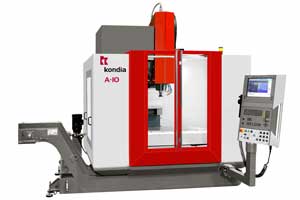
Conocimiento de la competencia
- El 50 por ciento de los encuestados conoce con detenimiento a su competencia real
- El 20 por ciento conoce los medios productivos de su competencia.
- El 55 por ciento conoce la estrategia comercial de su competencia.
Comparación con el líder
- El 85 por ciento de los encuestados conoce las tendencias que definen los líderes y sus diferencias con respecto a él.
Comparación con la competencia
- El 95 por ciento de los encuestados conoce las diferencias de sus productos con respecto a los de su competencia.
Comparación de atributos con respecto a la competencia
Se ha obtenido la siguiente tabla en la que se estudian los productos de las empresas consultadas en comparación con su competencia más directa.
Se puede resaltar la incidencia del precio de las máquinas que en el 75 por ciento de las empresas consultadas están mejor posicionados que su competencia.
- En el 80 por ciento de los casos se identifica con un servicio al cliente mejor o igual que el de su competencia.
- El 70 por ciento de las veces el diseño de las máquinas es mejor o igual que el de la competencia.
- En el 65 por ciento de los casos sólo se está mejor o igual en cuanto a calidad percibida.
Si ahora nos fijamos exclusivamente en las valoraciones de mejor posicionamiento, veremos que es el precio el que toma mayor peso en la ventaja respecto a los competidores. Este dato puede representar una debilidad en los otros aspectos diferenciales, presuponiendo carencias, e indicando una situación de peligro en épocas en las que el ciclo económico se encuentre en recesión. Quien disponga de otros argumentos de venta de peso, estará supuestamente en mejor situación para afrontar años de crisis y en los de bonanza será mas valorado, pudiéndosele admitir precios superiores a quienes no ofrecen características diferenciadoras de servicio o de percepción de calidad
Atributos a transmitir para ser competitivos
Las empresas definen una serie de atributos en los que deben insistir para ser más competitivos, los resultados de las encuestas son los siguientes:
- Fiabilidad 44 %
- Relación calidad-precio 22 %
- Mejorar el diseño para que refleje la calidad de la máquina 17 %
- Imagen de tecnología, diferenciada de la competencia 17 %
- Robustez 17 %
- Servicio 11 %
- Productividad 6 %
- Operatividad-manejabilidad de máquina 6 %
- Rigidez 6 %
- Durabilidad 6 %
- Precisión 6 %
- Vida útil 6 %
- Garantía 6 %
- Expectación 6 %
- Creatividad 6 %
- Rentabilidad 6 %
- Reconocimiento 6 %
De estos datos y en lo que al diseño industrial afecta destacaríamos como atributos intangibles, no medibles, la robustez aparente, imagen de tecnología, la calidad percibida de las máquinas, creatividad, etc., adquiriendo valoraciones elevadas, que si se agrupasen sumarían a mas del 50 por ciento de los encuestados. Esto deja de nuevo entrever la necesidad del sector de disponer de herramientas que les permitan ganar ante potenciales clientes en credibilidad sobre los buenos productos que fabrican, que juzgan ser intrínsecamente productos de una calidad media alta.
Valoración de certificaciones
Sólo en un 65 por ciento de las encuestas se ha resaltado la importancia en el sector de las certificaciones de calidad y medioambientales.




